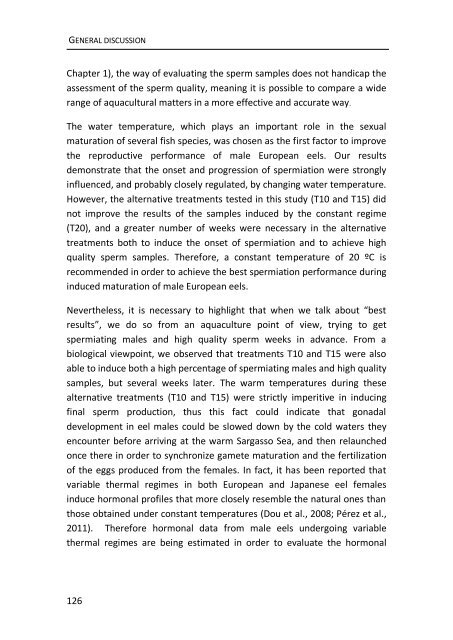chapter 3 - RiuNet
chapter 3 - RiuNet
chapter 3 - RiuNet
Create successful ePaper yourself
Turn your PDF publications into a flip-book with our unique Google optimized e-Paper software.
GENERAL DISCUSSION<br />
Chapter 1), the way of evaluating the sperm samples does not handicap the<br />
assessment of the sperm quality, meaning it is possible to compare a wide<br />
range of aquacultural matters in a more effective and accurate way.<br />
The water temperature, which plays an important role in the sexual<br />
maturation of several fish species, was chosen as the first factor to improve<br />
the reproductive performance of male European eels. Our results<br />
demonstrate that the onset and progression of spermiation were strongly<br />
influenced, and probably closely regulated, by changing water temperature.<br />
However, the alternative treatments tested in this study (T10 and T15) did<br />
not improve the results of the samples induced by the constant regime<br />
(T20), and a greater number of weeks were necessary in the alternative<br />
treatments both to induce the onset of spermiation and to achieve high<br />
quality sperm samples. Therefore, a constant temperature of 20 ºC is<br />
recommended in order to achieve the best spermiation performance during<br />
induced maturation of male European eels.<br />
Nevertheless, it is necessary to highlight that when we talk about “best<br />
results”, we do so from an aquaculture point of view, trying to get<br />
spermiating males and high quality sperm weeks in advance. From a<br />
biological viewpoint, we observed that treatments T10 and T15 were also<br />
able to induce both a high percentage of spermiating males and high quality<br />
samples, but several weeks later. The warm temperatures during these<br />
alternative treatments (T10 and T15) were strictly imperitive in inducing<br />
final sperm production, thus this fact could indicate that gonadal<br />
development in eel males could be slowed down by the cold waters they<br />
encounter before arriving at the warm Sargasso Sea, and then relaunched<br />
once there in order to synchronize gamete maturation and the fertilization<br />
of the eggs produced from the females. In fact, it has been reported that<br />
variable thermal regimes in both European and Japanese eel females<br />
induce hormonal profiles that more closely resemble the natural ones than<br />
those obtained under constant temperatures (Dou et al., 2008; Pérez et al.,<br />
2011). Therefore hormonal data from male eels undergoing variable<br />
thermal regimes are being estimated in order to evaluate the hormonal<br />
126
















